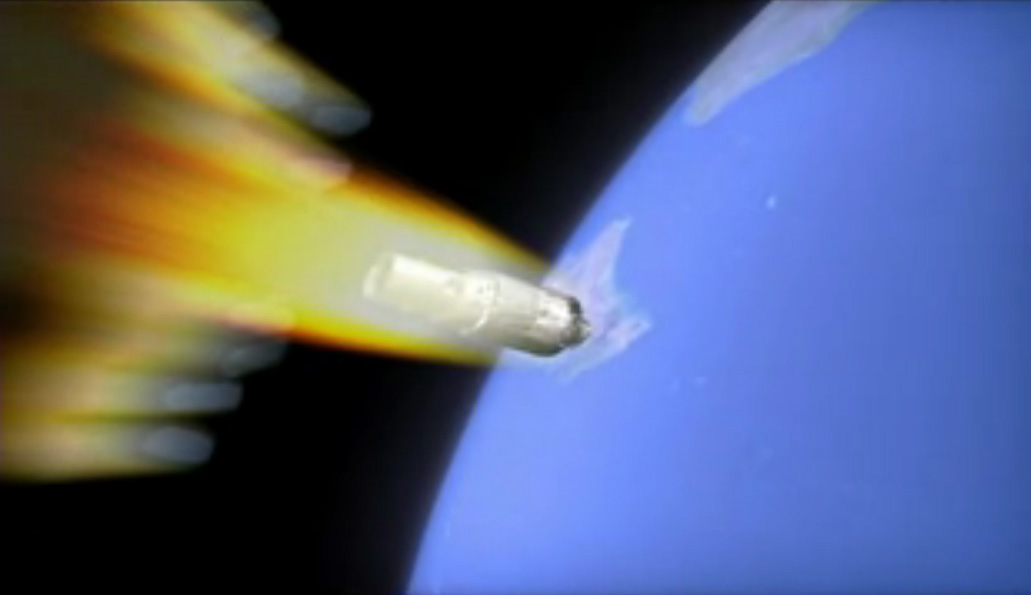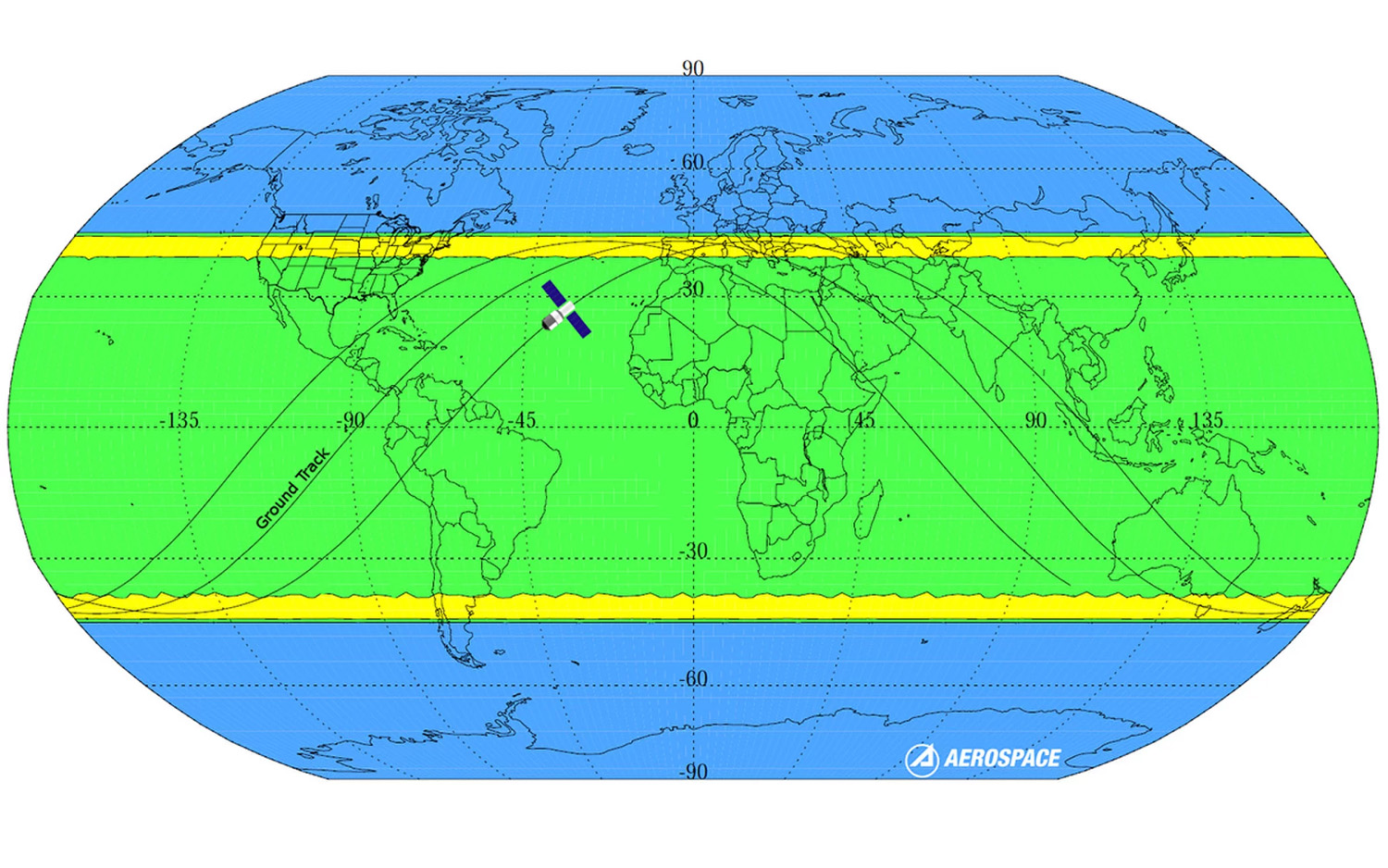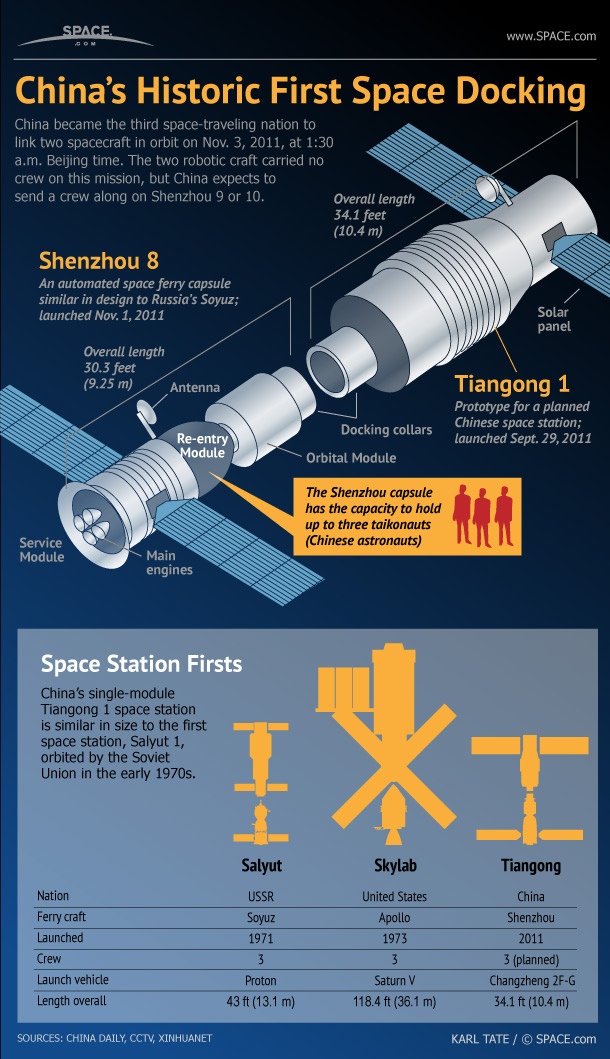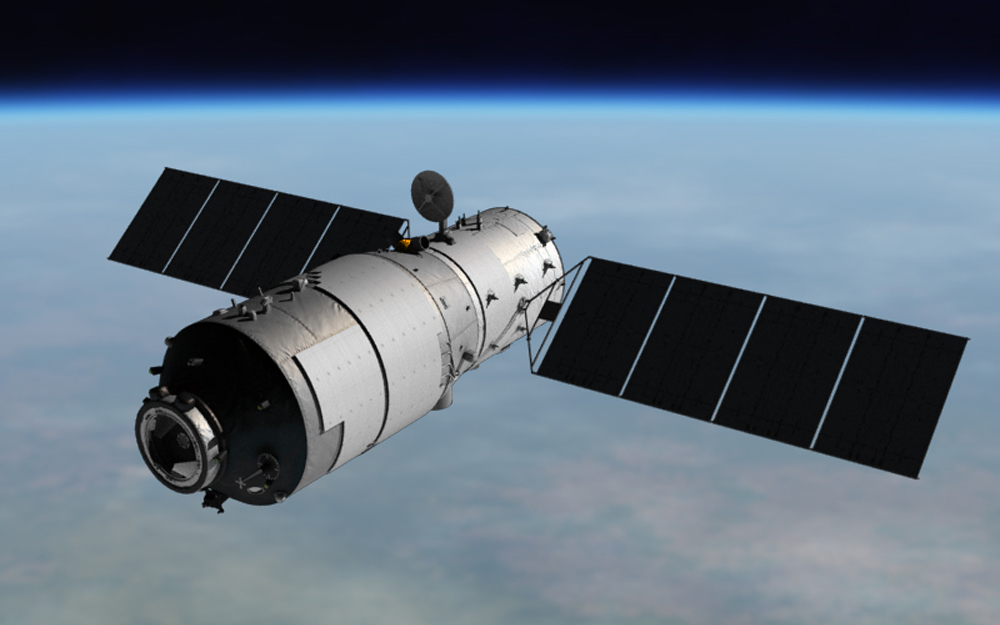Chinese Space Station Tiangong-1 Falling to Earth Now, But Where?
Update for 9:30 p.m. EDT: China's Tiangong-1 space station fell to Earth above the southern Pacific Ocean today (April 1) at 8:16 p.m. EDT (0016 GMT on April 2). Read the full story: Farewell, Tiangong-1: Chinese Space Station Crashes in Fiery Finale Over South Pacific
It's almost crash time for China's falling space station Tiangong-1. As school bus-sized space station began what should be its last day in orbit today (April 1), experts weighed in on the possibilities of space debris – and whether this situation should have happened in the first place.
Tiangong-1 is expected to re-enter Earth's atmosphere sometime between Sunday evening and early Monday, according to the European Space Agency. The latest forecast from the non-profit Aerospace Corp. pegged the space station crash at 8:30 p.m. EDT tonight (0030 GMT Monday, April 2), give or take 1.7 hours. But the time of the re-entry – along with the geographic area – is still highly volatile as Tiangong-1 continues its descent. [Track Tiangong-1! Use This Satellite Tracker]
"We know that Tiangong-1 is tumbling, or at least it was when Germany took [a] radar update, so the question is it still tumbling, and is the tumbling getting faster or slower," Andrew Abraham, a senior member of Aerospace's technical staff, told Space.com in an interview at 7 p.m. EDT Saturday (March 31) when the group released its latest forecast. He noted that the time of re-entry keeps getting pushed into the future, so the window of uncertainty remains large. As the re-entry time approaches, the range of re-entry times will narrow.

As of today, Tiangong-1 is flying in an orbit of 104 miles (167.6 kilometers) and falling, the China Manned Space Engineering Office said in a statement cited by Xinhua News Service. CMSEO officials have said Tiangong-1 will mostly burn up in the Earth's atmosphere, and is unlikely to cause any damage on the ground, CMSEO officials added.
Although Abraham said this is speculation on the part of Aerospace, he said it is possible Tiangong-1 is now encountering more of Earth's atmosphere as it falls towards the surface of the planet. If that's the case, the atmosphere might be influencing the attitude or orientation of Tiangong-1's tumble. He compared the situation to an arrow moving through the air, or a wind vane undulating in the wind. "They align themselves to the direction of travel," he said. "There's a bit higher drag in the back, and the center of mass is towards the front."
Aerospace uses publicly available data from the United States Air Force in making its Tiangong-1 predictions. The military has a network of radar and optical telescopes, and publishes data at spacetrack.org. Abraham said after Tiangong-1 enters Earth's atmosphere, there may be a delay of a few hours to confirm it. That's because Aerospace will wait for information from multiple sensors, in the case that Tiangong-1-'s descent isn't observed.
Get the Space.com Newsletter
Breaking space news, the latest updates on rocket launches, skywatching events and more!

Uncontrollable fall

Chinese space officials lost contact with the 9.4-ton (8.5-metric ton) station in 2016 after five successful years of operations, including two visits by Chinese crews of astronauts. China did not make it clear if they cut off contact with the station deliberately, or if they lost telemetry with Tiangong-1 due to a technical issue. Whatever the cause, the result was the same: Tiangong-1 began an inevitable descent into Earth's atmosphere.[China's Falling Space Station: Everything You Need to Know]
"This should not have happened," David Barnhart, a satellite designer who is the director of the University of Southern California's space technology and systems group, told Space.com Saturday (March 30). "To date, almost everything we put into space, at some point, is going to die. But something that large, we now have the technology to go up to it and prolong its life."
He said the demise of Tiangong-1 raises questions about the end of the International Space Station, which is projected to host crews until at least 2024, if not longer. It's unclear what will happen to the ISS after that. While the nominal plan is to deorbit it, at least one commercial company is considering using modules of the ISS for its own research. Barnhart urged engineers to plan how to re-use ISS as soon as possible, to avoid throwing it away into the Earth's atmosphere.
Tiangong-1's orbital inclination carried it over most of Earth's populated areas, between 43 degrees north and 43 degrees south latitudes. The zone includes the United States, Central America, South America, Australia and much of Europe and Asia.
With so many people below Tiangong-1's path, its descent caused worldwide speculation about the dangers of space debris from the 9.4-ton (8.5-metric ton) module. Several entities closely monitored its fall and issued updates, including the China Manned Space Engineering (CMSE) Office, the European Space Agency's Space Debris Office in Germany, and Aerospace Corp.
Space debris concerns
Late in Tiangong-1's life, it was unclear how much debris would make it down to the surface.
"Our company has the ability to do that [predict space debris] if we have a firm idea of the exact composition of the space object … especially ones in which we're involved with the design," Abraham told Space.com in another interview earlier Saturday (March 31). [The Biggest Spacecraft to Fall Uncontrolled From Space]
"But because China doesn't really send that information, the best we can tell you is between 10 percent and 40 percent of the mass of Tiangong-1 would survive," he added. Assuming the space station is 9.4 tons, this would imply roughly 1,880 to 7,520 pounds (850 to 3,411 kg) would reach the surface, he confirmed, but this is a broad generalization given that Aerospace does not have Tiangong-1's exact composition.
While Space Safety Magazine gave similar space debris predictions, other people said not nearly as much material would make it through the atmosphere. In an interview with Space.com sister site Live Science, Harvard University astrophysicist Jonathan McDowell predicted only 220 lbs. to 440 lbs. (100 to 200 kg) would survive the descent.

USC's Barnhart said perhaps a couple of hundred pounds would make it to the surface, but that depends on many factors – the angle of Tiangong-1's re-entry, the melting point of any metals on board, and how shielded the inside of the space station will be from re-entry. He added that trying to predict Tiangong-1's generated space debris is no worse than other uncontrolled re-entries he saw. "It's pretty complicated stuff, but this is normal," Barnhart said.
China's CSME, for its part, told the public that little of Tiangong-1 would survive, and added it would most likely splash down somewhere in the ocean since water covers 70 percent of the Earth's surface.
"It won't crash to the Earth fiercely, as in sci-fi movie scenarios, but will look more like a shower of meteors," read a March 29 update from CMSE, according to the Chinese state media outlet Xinhua.
How Tiangong-1 will break apart
The CMSE added that the disintegration of Tiangong-1 will take place in multiple phases, Xinhua added.
"During the first phase [of Tiangong-1's re-entry], the atmospheric drag will rip solar arrays, antennas, and other external parts off a spacecraft at an altitude of about 100 kilometers [62 miles]," Xinhua said, noting the station would likely disintegrate at 80 km (49 miles) in altitude. "The fragments will keep burning and most of them will get dissipated in air. Only a small amount of debris will reach the ground, and will float down at a very slow speed due to their small mass."
China began addressing safety concerns at least as far back as May 2017, when representatives from the Permanent Mission of the People's Republic of China made a statement to the United Nationsoutlining their plan to disseminate information through the media and government channels. Back then, they predicted re-entry would happen any time between October 2017 and April 2018.
As Tiangong-1's re-entry time drew close in March, the sun's activity confounded predictions. Forecasts of the sun's activity at first showed that a stream of particles would collide with Earth's atmosphere, causing it to balloon. The increased atmospheric density at Tiangong-1's low altitude would, predictions said, cause the station to fall faster into the atmosphere as its orbital speed slowed due to drag.
The sun remained quiescent, however, and Tiangong-1's final entry time was delayed by several days due to lower atmospheric density than expected. The atmosphere not only affects the resistance Tiangong-1 encountered in its orbit, but how it was expected to fall apart, Barnhart said. "Most platforms in space are made from some level of aluminum or titanium," he added. "Each has a different melting point, and they are also affected differently from the forces they will see in the atmosphere."
Fireballs and debris
The chance of Tiangong-1 hitting any single spot on the surface is extremely low; a particular person would have a far better chance of winning the Powerball jackpot, according to Live Science. The odds of getting hit by space station debris were about in 292 trillion. The odds of winning the Powerball are about one in 292 million, according to Aerospace Corp.
To Live Science, McDowell said that anyone underneath the re-entry path at night would likely see a spectacular show. "Fireballs are almost certain," he said in an e-mail. "What happens is that there are some dense sections of the lab connected together by a rather thin structure," McDowell added, explaining the source of the fireballs. "The thin structure melts first, turning the lab into a bunch — a few to a few dozen, depending — of independent pieces which melt and burn more slowly — fireballs."
Tiangong-1 is about the mass of ATV-1 "Jules Verne", a European cargo freighter that came back from the International Space Station in 2008. ESA deliberately targeted Jules Verne for a nighttime descent over the Pacific Ocean; a chase plane filmed fireballs lighting up the darkness. ESA posted footage of the light show in 2015. Aerospace Corp. said Tiangong-1 could generate fireballs of a similar magnitude, if it fell at night.
Tiangong-1 is just one example of large space modules falling apart in Earth's atmosphere. The descending Skylab space station famously dropped pieces into rural Australia, west of Perth, in 1979; however, Skylab was about 10 times more massive than Tiangong-1. Other prominent examples of uncontrolled re-entries include NASA's Upper Atmosphere Research Satellite (2011) and Europe's Gravity Field and Steady-State Ocean Circulation Explorer (2013).
Chinese space station operations remain active with a successor space station, called Tiangong-2. The newer station launched in September 2016, and astronauts aboard Shenzhou 11 visited Tiangong-2 in October and November 2016. China plans an even larger, multi-module space station that will be built in the 2020s.
Editor's note: If you spot Tiangong-1 streaking across your sky during its re-entry and capture video or images of the descent, let us know! You can send images and video in to spacephotos@space.com. This story was updated at 4:47 p.m. EDT to include the latest re-entry forecast by ESA and Aerospace Corp.
Visit Space.com today for complete coverage of the Tiangong-1 re-entry.
Follow us @Spacedotcom, Facebook and Google+. Original article on Space.com.
Join our Space Forums to keep talking space on the latest missions, night sky and more! And if you have a news tip, correction or comment, let us know at: community@space.com.

Elizabeth Howell (she/her), Ph.D., was a staff writer in the spaceflight channel between 2022 and 2024 specializing in Canadian space news. She was contributing writer for Space.com for 10 years from 2012 to 2024. Elizabeth's reporting includes multiple exclusives with the White House, leading world coverage about a lost-and-found space tomato on the International Space Station, witnessing five human spaceflight launches on two continents, flying parabolic, working inside a spacesuit, and participating in a simulated Mars mission. Her latest book, "Why Am I Taller?" (ECW Press, 2022) is co-written with astronaut Dave Williams.









